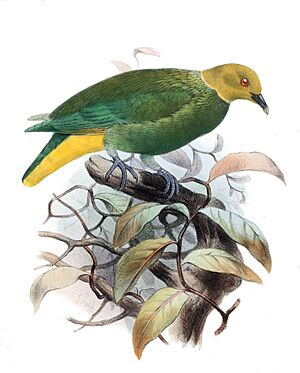Whistling fruit dove facts for kids
Quick facts for kids Whistling fruit dove |
|
|---|---|
 |
|
| Conservation status | |
| Scientific classification | |
| Genus: |
Ptilinopus
|
| Species: |
layardi
|
| Synonyms | |
|
Chrysoenas layardi |
|
The whistling fruit dove is a small, colorful bird found only on two islands in Fiji. It's also called the whistling dove because of its special call. People sometimes call it the velvet dove or yellow-headed dove too! This bird lives only on the islands of Kadavu and Ono, which are part of the Kadavu Group in southern Fiji.
Contents
About the Whistling Fruit Dove
The whistling fruit dove is a small bird, about 20 centimeters (8 inches) long. It has soft, velvety feathers. Male and female doves look a bit different. This is called sexual dimorphism.
What Do They Look Like?
Male whistling fruit doves have dark green feathers. Their heads are bright yellow, and they have yellow feathers under their tails. Female doves are mostly dark green and do not have the yellow head or undertail feathers.
How Do They Sound?
These doves can be hard to spot in the thick forest. But you can often find them by listening for their unique call! They make a clear whistle that goes up, then a soft 'tinkle' sound that goes down. It's like they are singing a special song.
Where Do Whistling Fruit Doves Live?
These amazing birds live high up in the trees of the Fijian forests. They spend most of their time in the forest canopy, which is the top layer of branches and leaves. This is where they find their food and build their nests.
What Do Whistling Fruit Doves Eat?
Whistling fruit doves are fruit eaters! They find all their food high in the forest canopy. They love to eat different kinds of fruits that grow on the trees.
Reproduction and Life Cycle
Scientists have not studied the breeding habits of the whistling fruit dove very much. We don't know a lot about how they raise their young.
Nests and Chicks
In 1982, a scientist described a nest that was found. It was a loose, thin platform made from twig-like vines. The nest was about 3 meters (10 feet) above the ground. Only one baby bird was found in this nest. It seemed that only the female dove took care of the young chick.
If this is true for all whistling fruit doves, it's quite interesting! In many other pigeon and dove species, both parents help raise the young. This difference in how parents care for their babies might explain why male and female whistling fruit doves look different.
Protecting Whistling Fruit Doves
The whistling fruit dove is considered "near threatened" by a group called the IUCN. This means they are not in immediate danger, but their numbers could become a problem in the future.
Population and Threats
Currently, there are many whistling fruit doves in the forests of Kadavu and Ono. Experts believe there are about 10,000 birds. However, these doves live in a very small area. Their numbers are slowly going down because of habitat loss. This means that the forests where they live are shrinking or being damaged. Protecting their forest homes is very important to keep these unique birds safe!


